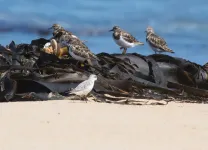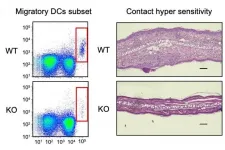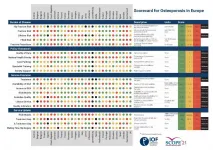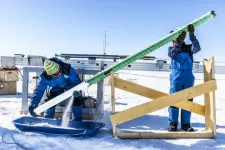(Press-News.org) As Australia officially enters winter, UniSA ecologists are urging coastal communities to embrace all that the season brings, including the sometimes-unwelcome deposits of brown seaweed that can accumulate on the southern shores.
While tidal seaweed (or sea wrack) may seem unsightly - especially at beach-side tourist destinations - new research from the University of South Australia shows that it plays a vital role for many migratory seabirds and should be protected.
In the first study of its kind, UniSA researchers show that beach-cast seaweed provides shelter, and a range of microclimates, in addition to food, that ensure the survival of many shore-bird species.
Specifically, sea wrack acts like a reverse-cycle air conditioner creating cooler conditions when the weather is hot and warmer conditions when it is cold, helping seabirds regulate their body temperatures.
UniSA researchers, Tim Davis and Associate Professor Gunnar Keppel, say that councils, residents and tourists must be educated about the ecological role of sea wrack and how removing it from beaches can have a significant impact on the environment and the survival of bird species.
"Australian beaches are renowned for stretches of golden sand - it's one of the main drawcards for tourists - so it's not altogether surprising that beachside destinations tend to favour a seaweed-free coastline," Davis says.
"The challenge is, however, that while people may see beach-cast sea wrack as an eye-sore, it actually has an ecological role to fulfill, particularly for migratory shorebirds.
"Our research shows that sea wrack provides important microclimates to help seabirds regulate their body temperatures - they mostly forage, rest and roost in the older, dryer wrack, which is warm throughout most of the day. However, they also seek refuge among fresh wrack in the early mornings when it is the warmest habitat available.
"Shore birds move between the different wrack types depending on the prevalent weather conditions. This helps them conserve and build sufficient energy stores for successful migration and reproduction in overseas breeding grounds.
"When sea wrack is removed, then so too are the habitats of these sea birds, and this can have a devastating impact on their populations."
Globally, beach-cast wrack is removed from many beaches worldwide, either for aesthetic reasons to increase tourism, for fertilisers, or to extract alginate for applications in the food and beverage industry, and the biomedical and bioengineering fields.
Currently, Australian has no guidelines for harvesting wrack.
"Sustainable management of all aspects of coastal environments is essential if we are to conserve the livelihoods of the species that rely upon them," Davis says.
"Until a code of practice is established, our coastal ecosystems will remain under threat."
INFORMATION:
This study was undertaken at Danger Point in South Australia, an important non-breeding ground for migratory shorebirds such as the Double-banded Plover (which migrates to New Zealand) and the Red-necked Stint (which migrates to Siberia).
Notes to editors:
* World Ocean's Day is 8 June https://www.un.org/en/observances/oceans-day
Media contact: Annabel Mansfield T: +61 8 8302 0351 M: +61 417 717 504
E: Annabel.Mansfield@unisa.edu.au
Osaka, Japan - In a new study, researchers from Osaka University discovered a novel molecular mechanism by which immune cells migrate to fight off infections. These findings may help in understanding the development of certain immune deficiency disorders and establish novel therapies against them.
Immune cells represent a diverse group of cells. Some circulate in the blood stream and migrate to infected tissues after receiving signals from damaged tissues. Others reside in tissues to take up the invading microbe, migrate to lymph nodes and activate an immune response. Therefore, to function effectively, the immune system's activities ...
June 7, 2021 - Nyon, Switzerland -- A new report by the International Osteoporosis Foundation (IOF) draws attention to the burden of osteoporosis and the gaps and inequalities in the provision of primary and secondary prevention of fractures due to osteoporosis across Europe. 'SCOPE 2021: a new scorecard for osteoporosis in Europe' provides detailed findings for the 27 countries of the European Union as well as Switzerland and the United Kingdom (referred to as 'EU27+2'), covering key indicators for four domains: burden of disease, policy framework, service provision and service uptake.
Professor John A. Kanis, IOF Honorary President and lead author of SCOPE, stated:
"Osteoporosis is a major concern in Europe as it results in 4.3 million fragility fractures and health ...
Scientists have established the most reliable estimates to date of past temperature variations in Antarctica.
They highlight significant differences in behaviour between West and East Antarctica.
This study makes it possible to test and consolidate future climate projections.
Antarctica has experienced significant temperature changes, especially since the last glacial period. An international collaboration including scientists from the CNRS1 has now challenged previously accepted estimates of these variations, using new measurements published on June 4, 2021 in Science. Their study highlights differences in behaviour between East and West Antarctica, connected in particular ...
New research identified a novel interaction between the SARS-CoV-2 spike protein and the galectin-3-binding protein (LGALS3BP) which could be a new therapeutic anti-viral target. The research also found the presence of detectable viral RNA in blood in COVID-19 patients is a strong predictor of mortality.
The paper, published today in Nature Communications, was led by a group of researchers from King's College London, Guy's and St Thomas' NHS Foundation Trust and King's British Heart Foundation Centre. The research was funded by the NIHR Guy's and St Thomas' Biomedical Research Centre and supported by grants from BHF.
In the study, authors analysed close to 500 blood samples from patients ...
Cows can pass on the hypoglycin A toxin through their milk, a study by the Martin Luther University Halle-Wittenberg (MLU) and the Leibniz Institute of Plant Biochemistry (IPB) in Toxins shows. The substance can cause severe symptoms in humans and animals. Small amounts of the toxin were detected in the raw milk of cows that grazed in a pasture exposed to sycamore maple. The team calls for further investigations to realistically assess the potential dangers.
High concentrations of hypoglycin A can be found in unripe akee and lychee fruit and in the seeds and seedlings of various maple trees. These include, for example, the sycamore maple, which is common throughout Europe. The toxin can cause severe illness in humans. In 2017, a team of researchers in India ...
Travellers abroad may pick up bacteria and other vectors containing genes conferring antimicrobial resistance which remain in the gut when returning to their home country, according to a study published in Genome Medicine.
A team of researchers at Washington University, USA and Maastricht University, Netherlands investigated the presence of antimicrobial resistance (AMR) genes in the human gut microbiome by analysing the faecal samples of 190 Dutch travellers before and after travel to destinations in Northern Africa, Eastern Africa, Southern Asia ...
RApid DIgital Crispr Approach (RADICA) is a molecular rapid testing methodology that allows absolute quantification of viral nucleic acids in 40-60 minutes.
RADICA is four times faster and significantly less expensive than conventional polymerase chain reaction (PCR) methods as it does not require costly equipment for precise temperature control and cycling.
Method has been tested on SARS-CoV-2 synthetic DNA and RNA, Epstein-Barr virus in human B cells and serum, and can be easily adapted to detect other kinds of viruses.
Singapore, 7 June 2021 - Researchers from Critical Analytics for Manufacturing Personalized-Medicine (CAMP), an Interdisciplinary Research Group (IRG) at the Singapore-MIT ...
Nanoclusters, which consist of several or even thousands of atoms, represent an important intermediate state between microscopic atoms and macroscopic matter. A profound comprehension of the composition, structure, and properties of nanoclusters is crucial for exploring or extending their functional applications. Among the numerous types of nanoclusters, metal chalcogenide supertetrahedral clusters (MCSCs) have attracted great attention since the 1980s for their uniform sizes, well-defined structures, and semiconductor properties. Notably, because ...
Russian paleontologists discovered the skull of a Pleistocene small cave bear with artificial damage in the Imanay Cave (Bashkiria, Russia). A bear aged 9-10 years was killed with a spear during hibernation about 35 thousand years ago. If the assumptions of scientists are confirmed, the find will become the world's first direct evidence of a Paleolithic man hunting for a small cave bear. The description of the skull was published in the Vestnik Archeologii, Anthropologii I Ethnographii.
"The hole in the skull could be either natural or artificial," said senior researcher of the laboratories at the Ural Branch of the Russian Academy of Sciences and ...
Measurement postulate is crucial to quantum mechanics. If we measure a quantum system, we can only get one of the eigenvalues of the measured observable, such as position, energy and so on, with a probability. Immediately after the measurement, the system will collapse into the corresponding eigenstate instantly, known as state collapse. It is argued that the non-cloning theorem is actually a result of the measurement postulate, because non-cloning theorem would also hold in classical physics. The possibility of cloning in classical physics is actually the ability to fully measure a classical system, ...







